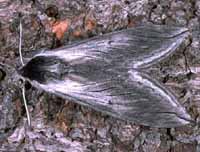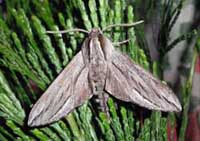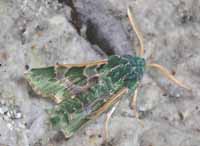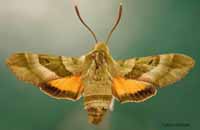Sphinginae subfamily
Sphingini tribe:
 |
This moth is recorded by USGS, but it is way out of its normal range. Unlikely! It is named for the wavy lines on the forewings. |
 |
This large bodied moth flies in tobacco fields and vegetable gardens
(potatoes, tomatoes) and wherever host plants are found. |
 |
Sphinx chersis USGS, the Northern Ash
Sphinx or Great Ash Sphinx
The upperside of the forewing is soft dark gray to blue-gray with a series of black dashes,
one of which reaches the wing tip. |
 |
Sphinx perelegans adults fly in montane woodlands and mixed chaparral-type vegetation as a single brood
in the north, with adults mainly on the wing in June and July.
It flies from dusk until after midnight. |
 |
This species is not reported in Jackson but is reported in Josephine.
Adults fly as a single brood in the desert and in pinyon-juniper
woodland from May to August. |
 |
Sphinx vashti USGS, the Snowberry Sphinx,
Snowberry Sphinx adults fly as a single brood in montane woodlands and along prairie
streamcourses from April to August.
The upperside of the forewing has a narrow black subterminal line
bordered by a white inverted V-shaped line on the outside, and a
black line at the apex. |
Smerinthini Tribe:
 |
The outer margin of the forewing is quite wavy. There is a dark cell spot and a dark oblique line mid wing from the costa almost to the
inner margin. Basic ground colour is pinkish brown. Flight would be June-July. |
 |
Pachysphinx modesta WO,
the Modest Sphinx or Poplar Sphinx,
This large poplar/willow feeder is probably rare in Jackson County,
near the southern most limit of its western range.
They are a heavy bodied species.
|
 |
This one is quite similar to Pachysphinx modesta, with modesta
being smaller and darker.
Moths should be on the wing from June-August.
|
 |
Smerinthus cerisyi USGS, the Cerisyi's
Sphinx or One-eyed Sphinx, Larvae feed on poplars and willows.
Flight would be from late May-July as a single brood.
|
Macroglossinae subfamily
Dilophonotini Tribe:
 |
Hemaris diffinis USGS, the Snowberry Clearwing or Bumblebee Moth,
The moth flies along forest edges and in meadows, gardens and
brushy fields. Day-flying adults nectar at lantana, dwarf bush honeysuckle,
snowberry, orange hawkweed, thistles, lilac, Canada violet, etc. |
Philampelini Tribe:
 |
This moth is reported for Jackson, but would probably be rare
in the northern most limit of its western range.
Fight would be from June to August. |
Macroglossini Tribe:
 |
Arctonotus lucidus USGS, the Pacific Green
Sphinx Moth or Bear SphinxThis species is confirmed in Jackson County.
It tends to be an early spring flier, on the wing in the
early
evening. It comes to lights at night. |
 |
Hyles lineata USGS, the White-lined Sphinx
Adults usually fly at dusk, during the night, and at dawn, but they
also fly during the day over a wide variety of open habitats
including deserts, suburbs, and gardens. |
 |
Adults fly in the afternoon from April-June in oak woodland and
pine-oak woodland in foothills, nectaring from chia, heartleaf
milkweed, golden currant, bluedicks, fairyfans, vetches,
thistles, hedgenettles, etc. |
|
|